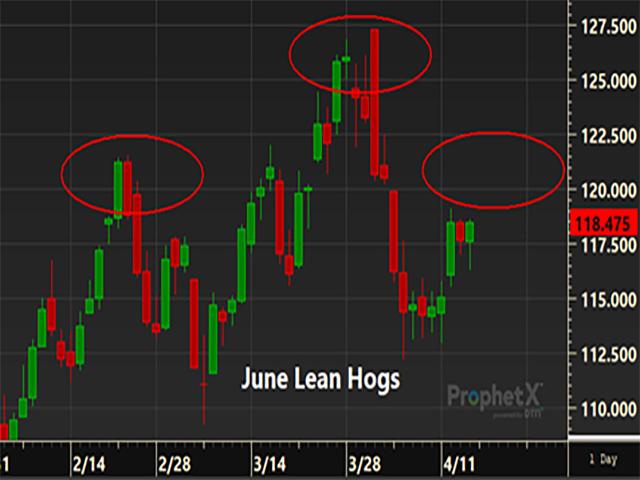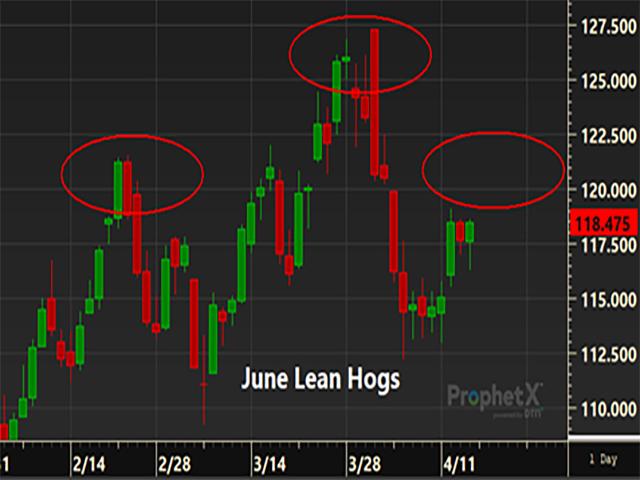Technically Speaking
Livestock Markets Get a Closer Look
Cattle futures have entered a consolidation phase following the corrective rally from March 4 to March 29, which could take the next several weeks to unfold. Supporting this consolidation call is the proximity to the 200-day moving average below and the 50-to 100-day moving averages above, two levels which should bracket price action moving forward. Momentum indicators have recovered from the early April selloff but are not yet suggesting a divergence of any kind. Fortunately, the market has identified some clear and present risk parameters from which to gauge directional bias. To the upside, the market needs to break the $138.525 corrective high from March 29 to render the consolidation phase over and a retest of the contract highs at $143.35 forthcoming. To the downside, the market needs to break the $132.475 corrective low from April 6 to reinstate the broader decline from the February highs. These issues considered, a neutral policy remains advised in live cattle with an acknowledgement that price action could get very choppy in the sessions immediately ahead inside this broader consolidation effort.
MAY FEEDER CATTLE:Often, feeder cattle and live cattle mirror each other with their technical construct. The present is not one of those times, however, as feeders have had a much more negative technical tilt the last couple months. After the recovery effort from March 4 to March 29, feeder cattle broke out to new lows below the March 4 lows unlike live cattle. Prices have recovered somewhat, but the overall chart picture remains negative. Momentum indicators have turned up, a supportive input for prices. All long-term moving averages lie well above the market, which will keep trend followers more willing to sell this market than buy it in the near term. A mountain of technical resistance exists in front of this market between spot prices and the $170.400 corrective highs from March 29. Provided feeders do not retest the April 11 lows, consolidation is likely ahead. If feeder cattle can exhibit trendy behavior higher, the $156.85 lows will look solid.
P[L1] D[0x0] M[300x250] OOP[F] ADUNIT[] T[]
Hog futures find themselves in a somewhat precarious position since peaking on March 31. The rebound from the April 5 lows is consistent with a bear market correction, or b-wave of a larger-degree a-b-c corrective sequence. Under that count, a bearish divergence in momentum should signal the end of the b-wave and subsequent reinstatement of a broader move south. On top of that, the hog market is also tracing out a head-and-shoulders pattern with current prices forming the right shoulder. Under that scenario, a break of the neckline between $109.15 and $112.20 would be expected to produce sharply lower prices straightaway. Using Fibonacci progression targets, a decline to $94.50-$95.00 could be expected. Therefore, to negate either of those bearish counts, lean hogs have to perform with trendy, impulsive behavior higher. Simply put, prices need to rally to stave off a selloff. Therefore, we would like to see early week trade above $119.10 and a move toward the $120-$122 level rather quickly to keep upside momentum alive. If prices head back toward $112.00, traders should position for additional downside losses.
**
Comments above are for educational purposes and are not meant to be specific trade recommendations. The buying and selling of grain and soybean futures involve substantial risk and are not suitable for everyone.
Tregg Cronin can be reached at tmcronin31@gmail.com
Follow Tregg on Twitter @5thWave_tcronin
(c) Copyright 2022 DTN, LLC. All rights reserved.








Comments
To comment, please Log In or Join our Community .